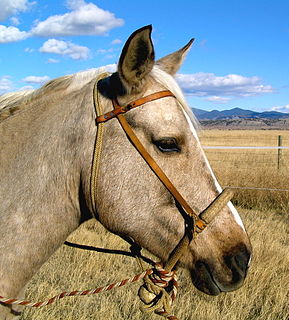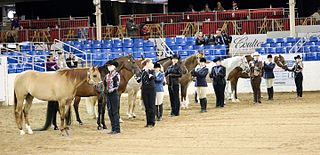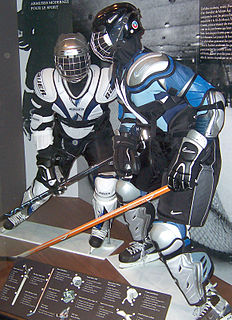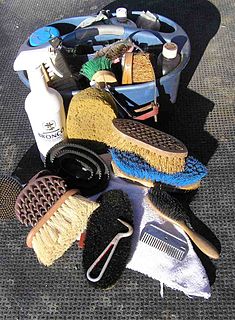
A diving mask is an item of diving equipment that allows underwater divers, including scuba divers, free-divers, and snorkelers, to see clearly underwater. Surface supplied divers usually use a full face mask or diving helmet, but in some systems the half mask may be used. When the human eye is in direct contact with water as opposed to air, its normal environment, light entering the eye is refracted by a different angle and the eye is unable to focus the light on the retina. By providing an air space in front of the eyes, the eye is able to focus nearly normally. The shape of the air space in the mask slightly affects the ability to focus. Corrective lenses can be fitted to the inside surface of the viewport or contact lenses may be worn inside the mask to allow normal vision for people with focusing defects.

Goggles, or safety glasses, are forms of protective eyewear that usually enclose or protect the area surrounding the eye in order to prevent particulates, water or chemicals from striking the eyes. They are used in chemistry laboratories and in woodworking. They are often used in snow sports as well, and in swimming. Goggles are often worn when using power tools such as drills or chainsaws to prevent flying particles from damaging the eyes. Many types of goggles are available as prescription goggles for those with vision problems.

A gag is a device used in sexual bondage and BDSM roleplay. Gags are usually associated with roleplays involving bondage, but that is not necessarily the case. The person who wears the gag is regarded as the submissive partner, while the other is regarded as the dominant one. People may wear gags for a variety of reasons. Some people derive erotic pleasure from a gag, either in a submissive or dominant role. When combined with other physical restraints, the wearing of a gag can increase the wearer's sense of helplessness and anxiety level within a BDSM scene by rendering them unable to speak during sexual activity, which some people enjoy.

A bridle is a piece of equipment used to direct a horse. As defined in the Oxford English Dictionary, the "bridle" includes both the headstall that holds a bit that goes in the mouth of a horse, and the reins that are attached to the bit.

A halter or headcollar is headgear that is used to lead or tie up livestock and, occasionally, other animals; it fits behind the ears, and around the muzzle. To handle the animal, usually a lead rope is attached. On smaller animals, such as dogs, a leash is attached to the halter.

Eye protection is protective gear for the eyes, and sometimes face, designed to reduce the risk of injury. Examples of risks requiring eye protection can include: impact from particles or debris, light or radiation, wind blast, heat, sea spray or impact from some type of ball or puck used in sports.

A horse blanket or rug is a blanket or animal coat intended for keeping a horse or other equine warm or otherwise protected from wind or other elements. They are tailored to fit around a horse's body from chest to rump, with straps crossing underneath the belly to secure the blanket yet allowing the horse to move about freely. Most have one or two straps that buckle in front, but a few designs have a closed front and must be slipped over a horse's head. Some designs also have small straps that loop lightly around the horse's hind legs to prevent the blanket from slipping sideways.

A noseband is the part of a horse's bridle that encircles the nose and jaw of the horse. In English riding, where the noseband is separately attached to its own headstall or crownpiece, held independently of the bit, it is often called a cavesson or caveson noseband. In other styles of riding, a simple noseband is sometimes attached directly to the same headstall as the bit.

Blinkers, sometimes known as blinders, are a piece of horse tack that prevent the horse seeing to the rear and, in some cases, to the side.

A hackamore is a type of animal headgear which does not have a bit. Instead, it has a special type of noseband that works on pressure points on the face, nose, and chin. Hackamores are most often seen in western riding and other styles of riding derived from Spanish traditions, and are occasionally seen in some English riding disciplines such as show jumping and the stadium phase of eventing. Various hackamore designs are also popular for endurance riding. While usually used to start young horses, they are often seen on mature horses with dental issues that make bit use painful, and on horses with mouth or tongue injuries that would be aggravated by a bit. Some riders also like to use them in the winter to avoid putting a frozen metal bit into a horse's mouth.

Showmanship is an event found at many horse shows. The class is also sometimes called "Fitting and Showmanship", "Showmanship In-Hand", "Showmanship at Halter" or "Halter Showmanship" It involves a person on the ground leading a horse, wearing a halter or bridle, through a series of maneuvers called a pattern. The horse itself is not judged on its conformation. Exhibitors are judged on exhibiting the animal to its best advantage, with additional scoring for the grooming and presentation of both horse and handler.

A mechanical hackamore is a piece of horse tack that is a type of bitless headgear for horses where the reins connect to shanks placed between a noseband and a curb chain. Other names include "hackamore bit", "brockamore", "English hackamore", "nose bridle" and "German hackamore". Certain designs have been called "Blair's Pattern" and the "W. S. Bitless Pelham".

In ice hockey, players use specialized equipment both to facilitate the play of the game and for protection as this is a sport where injuries are common, therefore, all players are encouraged to protect their bodies from bruises and severe fractures.

Horse grooming is hygienic care given to a horse, or a process by which the horse's physical appearance is enhanced for horse shows or other types of competition.

A bitless bridle is a general term describing a wide range of headgear for horses or other animals that controls the animal without using a bit. Direction control may also be via a noseband or cavesson, if one is used. The term hackamore is the most historically accurate word for most common forms of bitless headgear. However, some modern bitless designs of horse headgear lack the heavy noseband of a true hackamore and instead use straps that tighten around a horse's head to apply pressure in various ways. These are often specifically patented and marketed as "bitless bridles", usually referencing a particular type of headgear known as the cross-under, though other designs are sometimes also given similar names.

Protective equipment in gridiron football consists of equipment worn by football players for the protection of the body during the course of a football game. Basic equipment worn by most football players include helmet, shoulder pads, gloves, shoes, and thigh and knee pads, a mouthguard, and a jockstrap or compression shorts with or without a protective cup. Neck rolls, elbow pads, hip pads, tailbone pads, rib pads, and other equipment may be worn in addition to the aforementioned basics. Football protective equipment is made of synthetic materials: foam rubbers, elastics, and durable, shock-resistant, molded plastic. Football protective equipment has remained consistent in use for decades with some slight modifications made over the years in design and materials. The assignment and maintenance of football gear belongs to the team equipment manager.

A frentera is a part of some halters and bridles, usually on a horse. It is a cord, strap, or chain on the face of the horse that is attached to the crownpiece or browband and runs down the horse's face to the noseband or bit rings. A frentera can be split at the top to pass on either side of the forelock, or on either side of the ears. In the latter case, the frentera usually substitutes for a browband. A frentera can also be split at the bottom into two or more parts to support and stabilize a heavy noseband or bit.

The Newstead Helmet is an iron Roman cavalry helmet dating to 80–100 AD that was discovered at the site of a Roman fort in Newstead, near Melrose in Roxburghshire, Scotland in 1905. It is now part of the Newstead Collection at the National Museum in Edinburgh. The helmet would have been worn by auxiliary cavalrymen in cavalry displays known as hippika gymnasia. Its discoverer, Sir James Curle (1862–1944), described the helmet as "one of the most beautiful things that the receding tide of Roman conquest has left behind".

The Emesa helmet is a Roman cavalry helmet from the early first century AD. It consists of an iron head piece and face mask, the latter of which is covered in a sheet of silver and presents the individualised portrait of a face, likely its owner. Decorations, some of which are gilded, adorn the head piece. Confiscated by Syrian police soon after looters discovered it amidst a complex of tombs in the modern-day city of Homs in 1936, eventually the helmet was restored thoroughly at the British Museum, and is now in the collection of the National Museum of Damascus. It has been exhibited internationally, although as of 2017, due to the Syrian civil war, the more valuable items owned by the National Museum are hidden in underground storage.






















